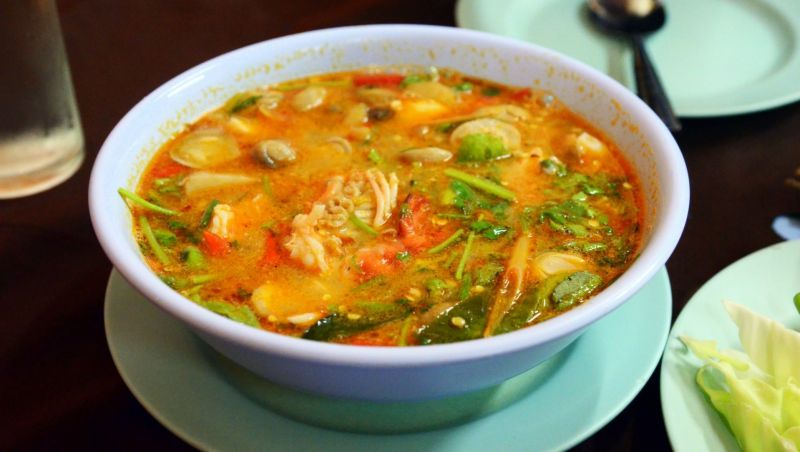The application should be submitted by March, and right now work is underway to collect as much knowledge and information about tom yum kung as possible, including the history of the dish, classic recipes etc.
At this point, some readers will be raising their eyebrows. Is there anything unclear about Thailand’s iconic soup and the most well-known Thai dish around the globe? The answer is actually “yes, nearly everything.” Tom yum is cooked in every Thai kitchen, with families passing their recipes down through generations, but Thai academics are yet to determine where the dish came from and how it evolved to its current status as a national symbol.
Announcing the plan to enshrine tom yum kung, the minister of culture said the term tom yum consists of tom, a Thai verb for boil, and yum, a Thai noun meaning spicy salad, which uniquely refers to a Thai cuisine belonging to the Central Plains. Kung is a Thai word with a broad meaning referring to prawns and shrimps, he added. In preparing the tom yum kung soup, prawns are boiled with various herbs and seasoned with local condiments, he concluded.
This was basically it for the gastronomic legend of Thailand. And this is what you find in most Thai and English sources too. Pretty scarce.
“I searched for the history of tom yum and came up empty-handed – in my experience, this is almost always the mark of a very ancient dish, one that preceded written recipes and has become such a part of the culture it does not need further explanation,” writes Susan Waggoner of culinary website Fork + Plate.
Susan spoke to Mark Wiens, an American culinary blogger and author residing in Thailand. An inspired explorer of Thai food, Mark not only enjoys the tastes of Thailand but also tries to understand the logic of Thai food with the help of his Thai wife and mother-in-law.
“There’s little information about the history of tom yum, but many say that it’s a central Thai soup that developed due to an abundance of freshwater shrimp. Boiled in water as a soup, the shrimp gave the broth a real fishy flavor, so cooks started experimenting by adding local Thai herbs into the boiling water to balance the fishy flavor. The trio of herbs that worked so well to infuse the broth with a beautiful aroma were kaffir lime leaves, lemongrass, and galangal, which are still the three most important ingredients in any bowl of tom yum,” Mark says.
Should we trust a foreigner when it comes to Thai food? Most likely yes in this case, as this is what you can hear from Thai experts such as M. L. Nueang Nilrat.
M. L. Nueang’s road to true tom yum also starts with the trio of kaffir lime leaves, lemongrass and galangal. She provides exhaustive directions on choosing, peeling and preparing shrimps which underlines the importance of this ingredient. Only then things like lime juice and fish sauce are mentioned as added to the soup to give it its final salty, sour and sweet taste.
All this makes it safe to presume that the heart of tom yum is shrimp broth infused with specific herbs and finally dressed to taste similar to yum salad.
Indeed, a really ancient Thai dish would hardly include tomatoes and chilli as both were unknown to Thais before the Columbian exchange with the Americas. Adding straw mushrooms is also unlikely to be an old feature, as shrimps and mushrooms are both sources of protein and duplicate each other. Dairy products were only recently introduced to the Thai diet, so creamy tom yum nam khon should also be considered a modern invention.
“The traditional tom yum broth was a clear soup or nam sai which becomes slightly richer in taste and more viscous with the help of fat from prawns’ heads. The thick broth – what we all know today as nam khon – later came into the picture and involves adding chilli paste, evaporated milk or coconut cream,” confirms Chef Chumpol Jangprai of R-Haan restaurant in the Michelin Guide Thailand 2019.
Starting from herb-infused shrimp or fish broth, tom yum kept developing through centuries reflecting the changes in Thai diet and availability of ingredients. For example, the Thaifoodmaster website shares a recipe of a peculiar tom yum, first published in 1890 Thai cookbook Tam Raa Gap Khao by Maawm Sohm Jeen (Raa Chaa Noopraphan). Named tom yum pla chon, the dish is more than just tom yum with snakehead fish (pla chon). Maawm Sohm Jeen adds richness to the broth by adding her own fried chilli paste and throws in some shredded green mango as a vegetable component. At the same time, the recipe doesn’t include kaffir lime or galangal, but still the heart of it is good fish broth, served with seasonings, giving it the desired spicy, salty, sour and sweet taste, characteristic of tom yum.
The 1890 recipe is a good illustration of how diverse Thai tom yum was even 129 years ago. With shrimp or fish, straw mushrooms or tomatoes, cream or shredded mango, it is still a soup loved by every Thai. Yet it remains very intriguing to hear what Thai academics will define tom yum as in their Unesco application.








